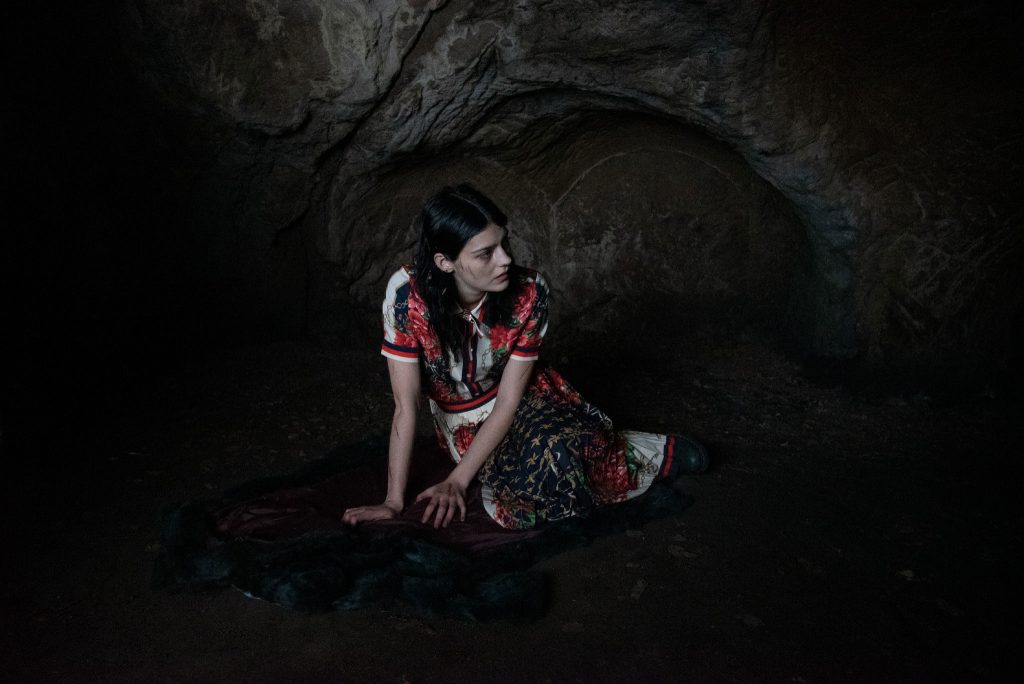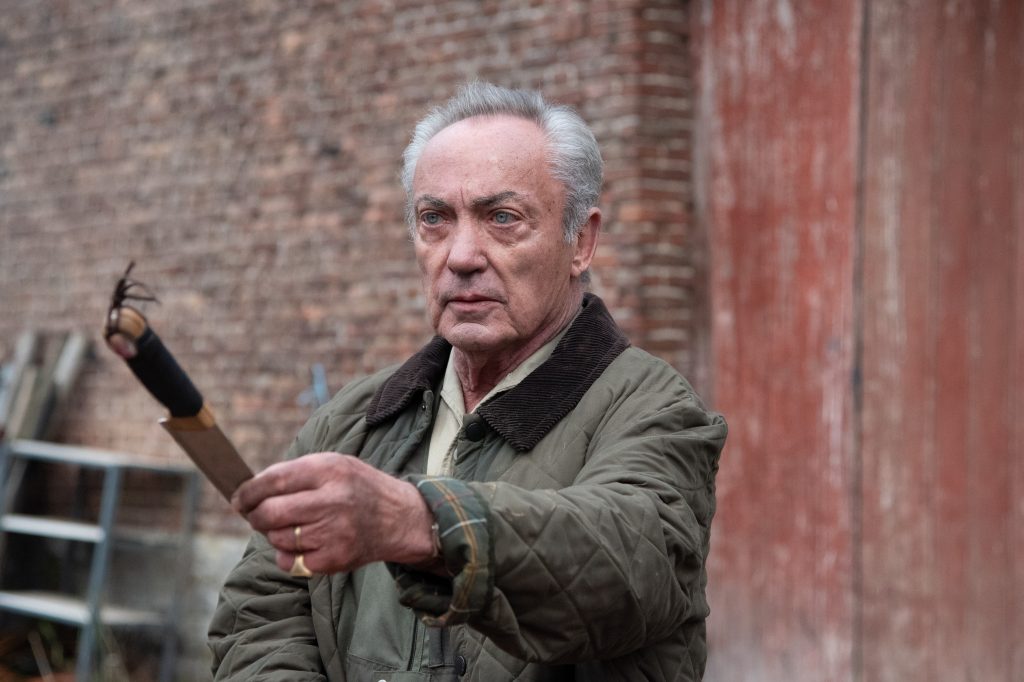October 27, 2021
by Carla Hay

Directed by Carlson Young
Culture Representation: Taking place in an unnamed Gulf Coast state and an unnamed Northern state in the United States, the horror film “The Blazing World” features a nearly all-white cast of characters (with a few African Americans) representing the working-class, middle-class and wealthy.
Culture Clash: A college student, who is haunted by the childhood death of her identical twin sister, experiences nightmarish hallucinations in her attempt to contact her sister from the dead.
Culture Audience: “The Blazing World” will appeal primarily to people who don’t mind watching horror movies that are more style over substance.

“The Blazing World” takes the concept of grief as an ongoing nightmare and jumbles it up in an incoherent horror movie. The cinematography is impressive, but the movie ultimately over-indulges in a lot of nonsense. Texas-born actress Carlson Young makes her feature-film debut as a writer and director in “The Blazing World,” which is based on her short film of the same name. Young also stars in “The Blazing World,” which has a bold and colorful visual style, but the screenplay (which Young co-wrote with Pierce Brown) is problematic because of its vapid emptiness.
In “The Blazing World,” Young portrays Margaret Winter, a college student who is haunted by the death of her identical twin sister Elizabeth, nicknamed Lizzie, who died by drowning in the family’s swimming pool when the twins were 6 years old. This death is shown in the beginning of the movie in a visually striking and eerie scene that might lead viewers to believe that “The Blazing World” might have potential of being a memorable horror movie.
In this flashback, 6-year-old Margaret (played by Josie Fink) and Elizabeth (played Lillie Fink) are dressed in identical pink dresses and catching fireflies outside in their backyard of their parents’ plantation-styled mansion that’s in an unnamed Gulf Coast state in America. (“The Blazing World” was actually filmed in Texas.) Margaret and Elizabeth’s parents Tom Winter (played by Dermot Mulroney) and Alice Winter (played by Vinessa Shaw) have a troubled marriage. Tom is an alcoholic, and he’s abusive to Alice.
Tom and Alice begin arguing inside the house, while Margaret and Elizabeth are outside. Margaret goes to a nearby window to look in on this argument. She hasn’t left Elizabeth’s side for very long when she makes a horrifying discovery: Elizabeth somehow ended up in the swimming pool, and she drowned.
Margaret also witnessed another frightening thing that she’s never talked about to other people: While Elizabeth was lying face down in the pool, Margaret saw a sinister-looking elderly man (played by Udo Kier) standing next to a black hole portal that’s suspended in the air in the backyard. The man made a beckoning hand gesture, indicating that he wanted Margaret to come over to him. Margaret was too scared to move, but throughout the story and into her adulthood, she keeps seeing this man, who eventually reveals to her that his name is Lained.
Of course, the Winter family is devastated by Elizabeth’s tragic death. There are some brief flashbacks to when Elizabeth was still alive. But, for the most part, “The Blazing World” takes place about 15 years after the drowning. Margaret grows up to be a mostly sad woman who struggles with mental health issues.
The movie then flash-forwards to when Margaret is living on campus at an unnamed university in a Northern state. There’s no indication of what she’s studying as a college student. But what is very clear is that Margaret is obsessed with the idea of different worldly dimensions. She’s a devoted fan of a TV personality named Dr. Cruz (played by Liz Mikel), who spouts theories on her TV show about alternate realities existing and that the human brain is able to access astral and spiritual portals.
There’s a somewehat unnecessary scene where Margaret, who lives near Dr. Cruz, happens to see Dr. Cruz walking to her car. Margaret approaches Dr. Cruz and gushes like a star-struck fan when she meets her. Dr. Cruz cynically tells Margaret that she fits the demographic of Dr. Cruz’s typical audience member: “Middle-class, 20s, white female: our key demographic. You keep us alive, whether I feel good about it or not. I’m not going to complain about a captive audience.”
When Margaret asks Dr. Cruz if someone can be trapped in an astral portal and brought back, Dr. Cruz vaguely answers: “Sometimes, if we don’t like the answers the world gives us, we just keep looking.” Margaret insists that she’s not crazy. It’s an assertion that she has to keep telling herself and other people when she starts seeing things that are very weird.
One day, Margaret gets a call from her mother Alice, who tells Margaret that Alice and Tom have sold their family home and that they are moving out soon. The fact that this is news to Margaret indicates how long it’s been since she and Alice have spoken to each other. Alice invites Margaret to go back to the family home to pick out any items that she wants to keep.
If Alice sounds medicated when she calls, that’s because she probably is. She mentions to Margaret that if Margaret has some Ambien pills, then Margaret should bring the Ambien with her when she comes to visit. Viewers can infer that Alice has become a pill-popping addict.
Alice is eager to see Margaret, but Margaret is reluctant to go back to the family home because it brings back bad memories for her. However, Margaret does back to the family home, where her parents’ marriage is just as miserable as ever, and her father’s alcoholism has gotten worse. Margaret’s visit triggers events that set her down a path of hallucinations where she sees more of Lained lurking around and sometimes near the black hole portal.
In many of these visions, Lained tries to kill her, such as by strangling her while she’s in a bathtub. Expect to see numerous scenes of Margaret having these visions and then suddenly waking up, as if she had a nightmare. It becomes repetitive to the point of inducing viewer boredom. It should come as no surprise that Margaret becomes convinced that Elizabeth is trapped in a portal somewhere, which leads to the part of the movie where Margaret tries to find Elizabeth so she can reunite with her twin.
“Blazing World” also has a time-wasting subplot of Margaret having a reunion in real life with an ex-boyfriend named Blake (played by John Karna), who takes her on a date to a nightclub named The Woods, which has a forest-themed decor and is eerily deserted. Blake recently completed rehab for drug addiction and is happy to see Margaret back in town again. He also makes it obvious that he wouldn’t mind getting back together with her, but Margaret doesn’t see Blake as more than a possible hookup. When Margaret tries to confide in him about her hallucinations, he assumes that her hallucinations are drug-related.
Three other friends whom Margaret knew from high school show up at The Woods, because this trio is a band that’s performing at the club. They are lead singer Margot (played by Soko), bass player Rob (played by Breckyn Hager) and drummer Sean (played by Ace Anderson). Margot does a tarot card reading for Margaret and states the obvious: “You’ve had a huge emotional loss. And everything that comes after that is a chain reaction to that early trauma. Be careful. If you spend too much time in the spiritual realm, you might not be able to come back.”
“Blazing World” seems to have the right intentions, but more thought should have been put into developing characters in the movie that viewers can care about, in order for the terror to be more effective. The hallucinations in the story can be described as candy-coated psychedelia. There are lots of hues in hot pink, bright red and neon blue. However, this eye-catching imagery can’t make up for the weak story arc that’s clumsily structured.
None of “The Blazing World” actors does anything remarkable. Kier’s Lained character is the most memorable, but Kier has played so many creepy characters in movies, this performance is just another version of those characters. “The Blazing World” could have been a tour-de-force showcase for Young as an actor/writer/director for this movie. Unfortunately, the result is a movie that looks like a poorly conceived student film that had the budget to afford cinematography and visual effects that are better than the average student film.
Vertical Entertainment released “The Blazing World” in select U.S. cinemas, on digital and VOD on October 15, 2021.








